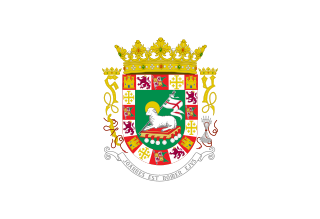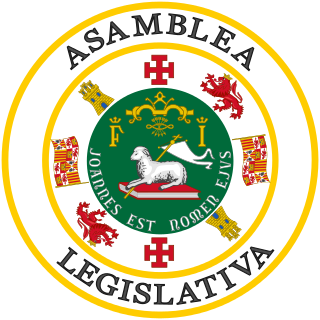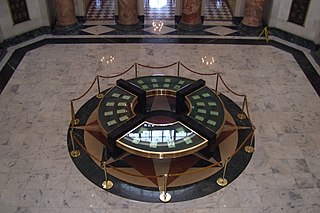Federal jurisdiction refers to the legal scope of the government's powers in the United States of America. See the 1962 Federal Report titled "JURISDICTION OVER FEDERAL AREAS WITHIN THE STATES".

Article Three of the United States Constitution establishes the judicial branch of the federal government. Under Article Three, the judicial branch consists of the Supreme Court of the United States, as well as lower courts created by Congress. Article Three empowers the courts to handle cases or controversies arising under federal law, as well as other enumerated areas. Article Three also defines treason.

The Eleventh Amendment to the United States Constitution was passed by Congress on March 4, 1794, and ratified by the states on February 7, 1795. The Eleventh Amendment restricts the ability of individuals to bring suit against states in federal court.

The federal government of the United States is the national government of the United States, a federal republic in North America, composed of 50 states, a federal district, five major self-governing territories and several island possessions. The federal government is composed of three distinct branches: legislative, executive and judicial, whose powers are vested by the U.S. Constitution in the Congress, the president and the federal courts, respectively. The powers and duties of these branches are further defined by acts of Congress, including the creation of executive departments and courts inferior to the Supreme Court.

The governor of Puerto Rico is the head of government of Puerto Rico and, by its nature, constitutes the executive branch of the government of the island. The governor is also the commander-in-chief of the island's military forces, the Puerto Rico National Guard.

The Senate of Puerto Rico is the upper house of the Legislative Assembly of Puerto Rico, the territorial legislature of Puerto Rico. The Senate, together with the House of Representatives of Puerto Rico, control the legislative branch of the government of Puerto Rico.

The Legislative Assembly of Puerto Rico is the territorial legislature of the Commonwealth of Puerto Rico, responsible for the legislative branch of the government of Puerto Rico. The Assembly is a bicameral legislature consisting of an upper house, the Senate normally composed by 27 senators, and the lower house, the House of Representatives normally composed by 51 representatives. Eleven members of each house are elected at-large rather than from a specific legislative district with all members being elected for a four-year term without term limits.
The United States territorial courts are tribunals established in territories of the United States by the United States Congress, pursuant to its power under Article Four of the United States Constitution, the Territorial Clause. Most United States territorial courts are defunct because the territories under their jurisdiction have become states or been retroceded.

The Privileges and Immunities Clause prevents a state from treating citizens of other states in a discriminatory manner. Additionally, a right of interstate travel may plausibly be inferred from the clause.

The United States District Court for the District of Puerto Rico is the federal district court whose jurisdiction comprises the Commonwealth of Puerto Rico. The court is based in San Juan. The main building is the Clemente Ruiz Nazario U.S. Courthouse located in the Hato Rey district of San Juan. The magistrate judges are located in the adjacent Federico Degetau Federal Building, and several senior district judges hold court at the Jose V. Toledo Federal Building and U.S. Courthouse in Old San Juan. The old courthouse also houses the U.S. Bankruptcy Court. Most appeals from this court are heard by the United States Court of Appeals for the First Circuit, which is headquartered in Boston but hears appeals at the Old San Juan courthouse for two sessions each year. Patent claims and claims against the U.S. government under the Tucker Act are appealed to the Federal Circuit.
Puerto Rico v. Branstad, 483 U.S. 219 (1987), was a case decided by the Supreme Court of the United States that ruled unanimously that federal courts have the power to enforce extraditions based on the Extradition Clause of Article Four of the United States Constitution. The decision overruled a prior decision in Kentucky v. Dennison, 24 How. 66 (1861), which had made federal courts powerless to order governors of other U.S. states to fulfill their obligations in the Extradition Clause.
Torres v. Puerto Rico, 442 U.S. 465 (1979), was a United States Supreme Court case holding that the Fourth Amendment guarantee against unreasonable search and seizure applies to Puerto Rico.

The political status of Puerto Rico is that of an unincorporated territory of the United States. As such, the island is neither a sovereign nation nor a U.S. state. Because of that ambiguity, the territory, as a polity, lacks certain rights but enjoys certain benefits that other polities have or lack. For instance, in contrast to sovereign nations, Puerto Rico does not have voting rights in its federal legislature nor in electing its federal head of government. But, in contrast to U.S. states, residents of Puerto Rico are not subject to federal income taxes. The political status of the island thus stems from how different Puerto Rico is politically from sovereign nations and from U.S. states.
Article Four of the Constitution of Puerto Rico describes the powers, structure, functions, responsibilities, and legal scope of the Governor of Puerto Rico, the executive branch of the government of Puerto Rico. The article establishes the term length of the governor and the requirements to hold such post, as well as establishing the governor as commander-in-chief of the militia, namely the Puerto Rico National Guard. It also establishes that the governor must present a State of the State address to the Legislative Assembly each year, as well as a report on the Budget of the Government of Puerto Rico.
The Judiciary of Puerto Rico is defined under the Constitution of Puerto Rico and consists of the Supreme Court of Puerto Rico, Court of Appeals, and the Court of First Instance consisting of the Superior Courts and the Municipal Courts.
Article Three of the Constitution of Puerto Rico describes the powers, structure, functions, responsibilities, and legal scope of the Legislative Assembly of Puerto Rico, the legislative branch of the government of Puerto Rico.
Puerto Rico v. Sanchez Valle, 579 U.S. ___ (2016), is a criminal case that came before the Supreme Court of the United States, which considered whether Puerto Rico and the federal government of the United States are separate sovereigns for purposes of the Double Jeopardy Clause of the US Constitution.








